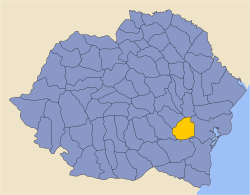Brăila County
County of Romania From Wikipedia, the free encyclopedia
County of Romania From Wikipedia, the free encyclopedia
Brăila County (Romanian pronunciation: [brəˈila] ) is a county (județ) of Romania, in Muntenia, with the capital city at Brăila.
Brăila County
Județul Brăila | |
|---|---|
County | |
 | |
 | |
| Coordinates: 45.11°N 27.68°E | |
| Country | |
| Development region1 | Sud-Est |
| Historic region | Muntenia |
| Capital city (Reședință de județ) | Brăila |
| Government | |
| • Type | County Council |
| • President of the County Council | Francisk-Iulian Chiriac (PSD) |
| • Prefect2 | Iulian Timofei |
| Area | |
| • County | 4,766 km2 (1,840 sq mi) |
| • Rank | 32nd in Romania |
| Population (2021-12-01)[1] | |
| • County | 281,452 |
| • Rank | 30th in Romania |
| • Density | 59/km2 (150/sq mi) |
| • Urban | 172,533 |
| Time zone | UTC+2 (EET) |
| • Summer (DST) | UTC+3 (EEST) |
| Postal Code | 81wxyz3 |
| Area code | +40 x394 |
| Car Plates | BR5 |
| GDP | US$1.930 billion (2015) |
| GDP/capita | US$6,315 (2015) |
| Website | County Council County Prefecture |
| 1The developing regions of Romania have no administrative role. They were formed just to attract funds from the European Union 2 as of 2007, the Prefect is not a politician, but a public functionary. He (or she) is not allowed to be a member of a political party, and is banned to have any political activity in the first six months after the resignation (or exclusion) from the public functionary corps 3w, x, y, and z are digits that indicate the city, the street, part of the street, or even the building of the address 4x is a digit indicating the operator: 2 for the former national operator, Romtelecom, and 3 for the other ground telephone networks 5used on both the plates of the vehicles that operate only in the county limits (like utility vehicles, ATVs, etc.), and the ones used outside the county | |
At the 2021 Romanian census, Brăila County had a population of 281,452 (172,533 people in urban areas and 108,919 people in rural areas.) and the population density was 59.1/km2 (152.9/sq mi).[2]
This county has a total area of 4,766 km2 (1,840 sq mi).
All the county lies on a flat plane: the Bărăgan Plain, one of the best areas for growing cereals in Romania.
On the east side there is the Danube, which forms an island – the Great Brăila Island –surrounded by the Măcin channel, Cremenea channel, and Vâlciu channel. On the northern side there is the Siret River and on the north-western side there is the Buzău River.
The agriculture is the main occupation in the county. Industry is almost entirely concentrated in the city of Brăila. The predominant industries in the county are:
In Brăila there is an important harbour, once the biggest cereal harbour in Romania.

The main tourist destinations are:
The Brăila County Council, renewed at the 2020 local elections, consists of 30 counsellors, with the following party composition:[5]
| Party | Seats | Current County Council | |||||||||||||||||
|---|---|---|---|---|---|---|---|---|---|---|---|---|---|---|---|---|---|---|---|
| Social Democratic Party (PSD) | 17 | ||||||||||||||||||
| National Liberal Party (PNL) | 10 | ||||||||||||||||||
| People's Movement Party (PMP) | 3 | ||||||||||||||||||


Brăila County has 1 municipality, 3 towns, and 40 communes
Județul Brăila | |
|---|---|
County (Județ) | |
 The Brăila County prefecture and court building from the interwar period, now the engineering building of Dunărea de Jos University. | |
 | |
| Country | |
| Historic region | Muntenia |
| Capital city (Reședință de județ) | Brăila |
| Area | |
| • Total | 4,286 km2 (1,655 sq mi) |
| Population (1930) | |
| • Total | 219,932 |
| • Density | 51/km2 (130/sq mi) |
| Time zone | UTC+2 (EET) |
| • Summer (DST) | UTC+3 (EEST) |
Historically, the county was located in the southeastern part of Greater Romania, in the northeastern part of the Muntenia region. Its territory included the portions of the current county to the east and south-east of the Buzău River. It was bordered on the west by the counties of Buzău and Râmnicu-Sărat, to the north by Covurlui County, to the east by Tulcea County, and to the south by the counties of Constanța and Ialomița.

The county was originally divided administratively into four districts (plăși):[6]
Subsequently, Plasa Călmățui, was abolished and two new districts were established in its place:

According to the 1930 census data, the county population was 219,831 inhabitants, ethnically divided as follows: 89.4% Romanians, 3.1% Jews, 2.2% Greeks, 0.7% Hungarians, 0.6% Russians, as well as other minorities.[7] From the religious point of view, the population was 93.6% Eastern Orthodox, 3.3% Jewish, 1.2% Roman Catholic, as well as other minorities.[8]
In 1930, the county's urban population was 68,347 inhabitants, comprising 75.4% Romanians, 9.7% Jews, 6.7% Greeks, 1.7% Hungarians, 1.6% Russians, as well as other minorities.[7] Mother tongues among the urban population were Romanian (82.6%), Greek (5.8%), Yiddish (4.8%), Russian (1.9%), Hungarian (1.5%), as well as other minorities. From the religious point of view, the urban population was composed of 84.4% Eastern Orthodox, 10.4% Jewish, 3.2% Roman Catholic, as well as other minorities.[8]
Seamless Wikipedia browsing. On steroids.
Every time you click a link to Wikipedia, Wiktionary or Wikiquote in your browser's search results, it will show the modern Wikiwand interface.
Wikiwand extension is a five stars, simple, with minimum permission required to keep your browsing private, safe and transparent.